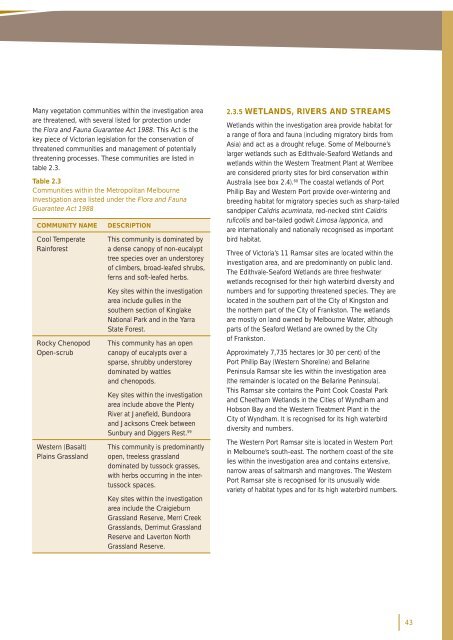Metropolitan Melbourne Investigation Discussion Paper - Victorian ...
Metropolitan Melbourne Investigation Discussion Paper - Victorian ...
Metropolitan Melbourne Investigation Discussion Paper - Victorian ...
You also want an ePaper? Increase the reach of your titles
YUMPU automatically turns print PDFs into web optimized ePapers that Google loves.
Many vegetation communities within the investigation area<br />
are threatened, with several listed for protection under<br />
the Flora and Fauna Guarantee Act 1988. This Act is the<br />
key piece of <strong>Victorian</strong> legislation for the conservation of<br />
threatened communities and management of potentially<br />
threatening processes. These communities are listed in<br />
table 2.3.<br />
Table 2.3<br />
Communities within the <strong>Metropolitan</strong> <strong>Melbourne</strong><br />
<strong>Investigation</strong> area listed under the Flora and Fauna<br />
Guarantee Act 1988<br />
COMMUNITY NAME<br />
Cool Temperate<br />
Rainforest<br />
Rocky Chenopod<br />
Open-scrub<br />
Western (Basalt)<br />
Plains Grassland<br />
DESCRIPTION<br />
This community is dominated by<br />
a dense canopy of non-eucalypt<br />
tree species over an understorey<br />
of climbers, broad-leafed shrubs,<br />
ferns and soft-leafed herbs.<br />
Key sites within the investigation<br />
area include gullies in the<br />
southern section of Kinglake<br />
National Park and in the Yarra<br />
State Forest.<br />
This community has an open<br />
canopy of eucalypts over a<br />
sparse, shrubby understorey<br />
dominated by wattles<br />
and chenopods.<br />
Key sites within the investigation<br />
area include above the Plenty<br />
River at Janefi eld, Bundoora<br />
and Jacksons Creek between<br />
Sunbury and Diggers Rest. 59<br />
This community is predominantly<br />
open, treeless grassland<br />
dominated by tussock grasses,<br />
with herbs occurring in the intertussock<br />
spaces.<br />
Key sites within the investigation<br />
area include the Craigieburn<br />
Grassland Reserve, Merri Creek<br />
Grasslands, Derrimut Grassland<br />
Reserve and Laverton North<br />
Grassland Reserve.<br />
2.3.5 WETLANDS, RIVERS AND STREAMS<br />
Wetlands within the investigation area provide habitat for<br />
a range of fl ora and fauna (including migratory birds from<br />
Asia) and act as a drought refuge. Some of <strong>Melbourne</strong>’s<br />
larger wetlands such as Edithvale-Seaford Wetlands and<br />
wetlands within the Western Treatment Plant at Werribee<br />
are considered priority sites for bird conservation within<br />
Australia (see box 2.4). 60 The coastal wetlands of Port<br />
Phillip Bay and Western Port provide over-wintering and<br />
breeding habitat for migratory species such as sharp-tailed<br />
sandpiper Calidris acuminata, red-necked stint Calidris<br />
rufi collis and bar-tailed godwit Limosa lapponica, and<br />
are internationally and nationally recognised as important<br />
bird habitat.<br />
Three of Victoria’s 11 Ramsar sites are located within the<br />
investigation area, and are predominantly on public land.<br />
The Edithvale-Seaford Wetlands are three freshwater<br />
wetlands recognised for their high waterbird diversity and<br />
numbers and for supporting threatened species. They are<br />
located in the southern part of the City of Kingston and<br />
the northern part of the City of Frankston. The wetlands<br />
are mostly on land owned by <strong>Melbourne</strong> Water, although<br />
parts of the Seaford Wetland are owned by the City<br />
of Frankston.<br />
Approximately 7,735 hectares (or 30 per cent) of the<br />
Port Phillip Bay (Western Shoreline) and Bellarine<br />
Peninsula Ramsar site lies within the investigation area<br />
(the remainder is located on the Bellarine Peninsula).<br />
This Ramsar site contains the Point Cook Coastal Park<br />
and Cheetham Wetlands in the Cities of Wyndham and<br />
Hobson Bay and the Western Treatment Plant in the<br />
City of Wyndham. It is recognised for its high waterbird<br />
diversity and numbers.<br />
The Western Port Ramsar site is located in Western Port<br />
in <strong>Melbourne</strong>’s south-east. The northern coast of the site<br />
lies within the investigation area and contains extensive,<br />
narrow areas of saltmarsh and mangroves. The Western<br />
Port Ramsar site is recognised for its unusually wide<br />
variety of habitat types and for its high waterbird numbers.<br />
43
















